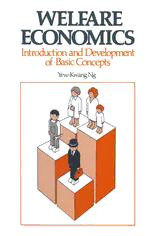
Welfare Economics: Introduction and Development of Basic Concepts PDF
Preview Welfare Economics: Introduction and Development of Basic Concepts
WELFARE ECONOMICS Related title published by Macmillan Education Peter Bohm SOCIAL EFFICIENCY: A CONCISE INTRODUCTION TO WELFARE ECONOMICS David J Mayston THE IDEA OF SOCIAL CHOICE eM Price WELFARE ECONOMICS IN THEORY AND PRACTICE S K Nath PERSPECTIVES OF WELFARE ECONOMICS Welfare Economics Introduction and Development of Basic Concepts YEW-KWANG NG Reader in Economics Monash University, Australia 3168 Simon Senior Research Fellow University of Manchester M © Yew-Kwang Ng 1979 Softcover reprint of the hardcover 1s t edition 1979 All rights reserved. No part of this publication may be reproduced or transmitted, in any form or by any means, without permission. First published 1979 by THE MACMILLAN PRESS LTD London and Basingstoke Associated companies in Delhi Dublin Hong Kong Johannesburg Lagos Melbourne New York Singapore and Tokyo Typeset by Reproduction Drawings Ltd, Sutton, Surrey British Library Cataloguing in Publication Data Ng, Yew-Kwang Welfare economics. 1. Welfare economics I. Title 330. IS'S HB99.3 ISBN 978-0-333-24296-4 ISBN 978-1-349-16223-9 (eBook) DOI 10.1007/978-1-349-16223-9 This book is sold subject to the standard conditions of the Net Book Agreement. The paperback edition of this book is sold subject to the condition that it shall not, by way of trade or otherwise, be lent, re-sold, hired out, or otherwise circulated without the publisher's prior consent in any fonn of binding or cover other than that in which it is published and without a similar condition including this condition being imposed on the subsequent purchaser. DEDICATED TO Siang, Aline, Eve and the welfare of all sentients Contents Preface xi List of Common Abbreviations xv List of Common Symbols xvi INTRODUCTION 1.1 What is welfare economics? 2 1.2 Is welfare economics a positive or normative study? 6 1.3* Welfare versus utility 7 1.4 Utility measurability and interpersonal comparability 12 1.5 The rest of this book 16 APPENDIX lA On basic value jedgements and subjective judgements of fact 18 APPENDIX 1 B On the existence of utility functions 25 2 PARETO OPTIMALITY 30 2.1 The Pareto principle 30 2.2 The conditions for Pareto optimality 32 2.3 The attainment of Pareto optimality 47 APPENDIX 2A· The first-order conditions for Pareto optimality 52 APPENDIX 2B" Pareto optimality of competitive equilibria 56 3 THE DIRECTION OF WELFARE CHANGE: WELF ARE CRITERIA 59 3.1 The debate about compensation tests 59 3.2 Taking distribution into account: Little's criterion 66 3.3 * Inadequacy of purely distributional rankings 72 APPENDIX 3A Community indifference contours 79 viii Contents 4 THE MAGNITUDE OF WELFARE CHANGE: CONSUMER SURPLUS 84 4.1 The origin of the concept: Dupuit and Marshall 84 4.2 Hicks' four measures and the average cost difference 85 4.3 Which measure? 90 4.4* Aggregation over commodities: The issue of path- dependency 92 4.5* Aggregation over individuals: The Boadway paradox 96 4.6** The approximate nature of surplus measurement 98 4.7* Some uses of surplus measurement 100 APPENDIX 4A** CV, EV or marginal dollar equivalent 105 5 SOCIAL CHOICE III 5.1 Arrow's impossibility theorem III 5.2* The impossibility propositions of Kemp-Ng and Parks 118 5.3* Can the paradox of social choice be resolved? 121 * 5 .4 Revealing the in tensities of pre ferences 127 5.5 The possibility of a Paretian liberal 137 APPENDIX SA * * The incompatibility of individualism and ordinalism 140 6 THE OPTIMAL DISTRIBUTION OF INCOME 147 6.1 Conceptual determination of optimal distribution 147 6.2 Utility illusion 150 6.3 Theories of optimal income distribution and taxation: Lerner and Mirrlees 151 6.4 General discussion 156 6.5 Concluding remarks 160 APPENDIX 6A * The excess burden of taxation: Can it be negative? 163 Contents ix 7 EXTERNALITY 166 7.1 The concept and classification of externalities 166 7.2 Divergence from optimality and the tax/subsidy solution 169 7.3 Other solutions 174 7.4** The conscience effect 176 7.5 * The Coase theorem and liability rules 182 8 PUBLIC GOODS 187 8.1 Basic characteristics of public goods 187 8.2 Optimality conditions and provision of public goods 190 8.3* An incentive-compatible mechanism for preference revelation 198 8.4* Income distribution as a peculiar public good: The paradox of redistribution 207 8.5* Economic theories of clubs 211 APPENDIX SA * The paradox of redistribution and the paradox of universal externality 214 9 FIRST, SECOND, OR THIRD BEST? 217 9.1 The theory of second best 218 9.2 Softening the blow of second best 224 9.3 A theory of third best 228 9.4 Towards a third-best policy 236 APPENDIX 9A ** A dollar is a dollar: Efficiency, equity, and third-best policies 244 10 CONCLUSION: TOWARDS A COMPLETE STUDY OF WELFARE? 264 10.1 Summary 264 10.2 Further considerations 267 10.3 Towards a complete study of welfare 276 x Contents APPENDIX lOA Notes and references on some advanced and applied topics 281 Addendum 290 References and Author Index 297 Subject Index 327
